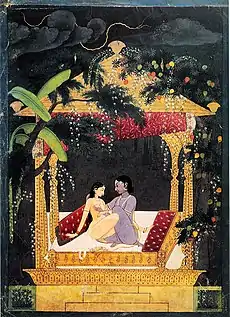| Krishna and Radha in a Pavilion | |
|---|---|
 | |
| Artist | Unknown artist |
| Year | circa 1760 |
| Type | Opaque watercolor on paper |
| Dimensions | 28 cm × 20 cm (11 in × 7.9 in) |
| Location | National Museum, New Delhi[1] |
Krishna and Radha in a Pavilion is an 18th-century rajput painting depicting the two Hindu deities Krishna and Radha engaged in sexual intimacy.[2]
Description
The painting is the example of pahari painting used in Gardner's Art Through the Ages, which states:[3]
In Krishna and Radha in a Pavilion, the lovers sit on a bed beneath a jeweled pavilion in a lush garden of ripe mangoes and flowering shrubs. Krishna gazes directly into Radha's face. Radha shyly averts her gaze. It is night, the time of trysts, and the dark monsoon sky momentarily lights up with a lightning flash indicating the moment's electric passion. Lightning is a standard symbol used in Rajput and Pahari miniatures to symbolize spiritual bliss and excitement.
Art scholar Stuart Cary Welch calls it a prime example of "Mughal naturalism combined with the tender lyricism of local traditions and Vaishnavite poetry."[1]
References
- 1 2 Stuart Cary Welch (1985). India; Art and Culture, 1300-1900. Metropolitan Museum of Art. p. 403. ISBN 9780030061141.
- ↑ Madelynn Dickerson (2013). The Handy Art History Answer Book. Visible Ink Press. p. 156. ISBN 9781578594627.
- ↑ Fred S. Kleiner (2015). Gardner's Art Through the Ages: A Global History. Cengage Learning. p. 1040. ISBN 9781305544840.